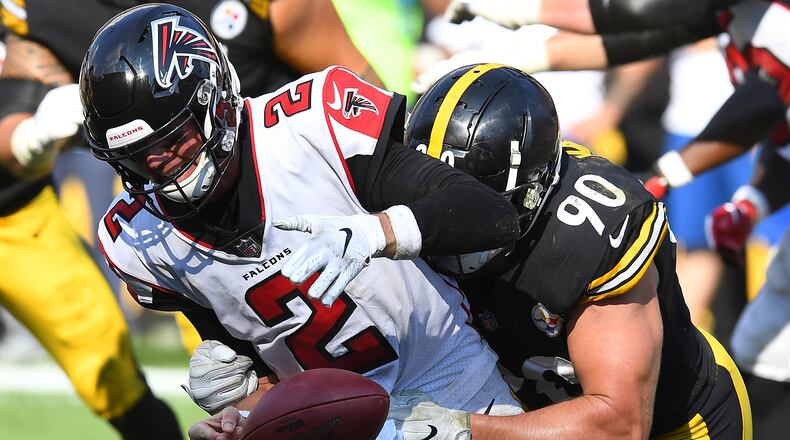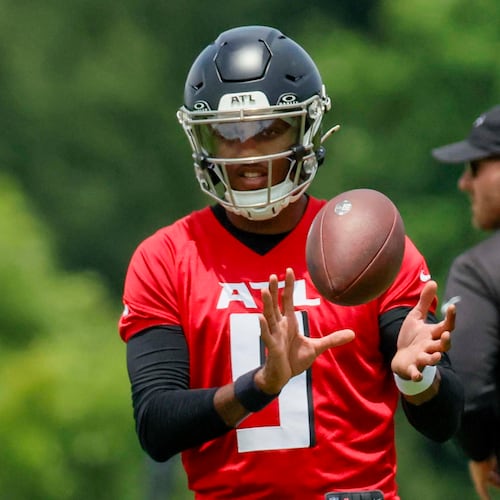In April, the Falcons will have a new philosophy for the NFL draft.
Under previous general manager Thomas Dimitroff, who spent over 12 years with the franchise, the method was to pick the best player at a position of need. Under new general manager Terry Fontenot, the Falcons will go with the best player available regardless of position.
This is something Fontenot is taking from his 18 years with the New Orleans Saints. It’s also a strategy that former Baltimore Ravens general manager Ozzie Newsome championed.
In the Ravens’ famous 1996 draft, Newsome steered the Ravens in the direction of selecting offensive tackle Jonathan Ogden fourth overall instead of running back Lawrence Phillips, who was owner Art Modell’s preferred selection. With the 26th overall pick, the Ravens took linebacker Ray Lewis, a player then considered undersized for the position.
Both Ogden and Lewis were inducted into the Pro Football Hall of Fame.
“You never want to reach for needs,” Fontenot said. “I think it’s cool listening to Ozzie Newsome tell stories about certain players on the board in certain areas, and they took the best player available, and he ends up taking Hall of Fame players as opposed to reaching for a need. We want to stack the board and be consistent. It’s never a bad thing to add to a strength.”
With the best-player-available strategy now implemented, here’s a look back at who the Falcons possibly could have selected in the first round of the past six drafts had this been the approach. In assessing this, Pro Football Focus’ Brent Rollins detailed how these players graded with the teams that drafted them.
2015, eighth overall pick: RB Todd Gurley (PFF career overall grade 78.9; rush grade 79.9)
The Falcons selected Vic Beasley with the eighth overall selection to bolster the pass rush. However, Gurley, the local hero who ran over opponents in college at Georgia, was sitting there for the taking.
Rollins: “After spending his first two years under Jeff Fisher, Gurley’s production exponentially increased once Sean McVay brought his offensive system to the Rams. While he’s tailed off recently as the mileage has increased, Gurley had an 82.4 overall grade, 123 explosive runs, 147 missed tackles forced as a runner and another 48 as a receiver in his first four seasons.”
2016, 17th overall pick: DT Kenny Clark (PFF career overall grade 90.1; run defense grade 87.3; pass-rush grade 87.8)
While safety Keanu Neal has done a great job when healthy, there is no denying Clark’s prowess up front. Clark, the second defensive tackle taken in 2016, and Grady Jarrett would have paired well as an interior tandem.
Rollins: “An absolute force in the middle of Green Bay’s defense since entering the league, Clark has also played at least 684 snaps in each of the past four seasons. In his career, Clark has 193 total quarterback pressures, including 18.5 sacks, 162 stops in the run game and only 18 missed tackles on 254 attempts while posting above average to elite grades every year in the league.”
2017, 26th overall pick: DE/OLB T.J. Watt (PFF career overall grade 91.1; run defense grade 90.0; pass-rush grade 91.5)
After reaching the Super Bowl, the Falcons traded up to take defensive end Takk McKinley 26th overall, with hopes that he and Beasley would form an envious pass-rushing tandem. That never materialized.
Rollins: “Very good in his first two years, Watt has been elite the past two seasons with 91.3 and 91.6 grades in 2019 and 2020, respectively. In addition to playing over 800 snaps each season, Watt has collected 250 total quarterback pressures, including 49.5 sacks, in his career.”
2018, 26th overall pick: WR Calvin Ridley (PFF career overall grade 81.8; receiving grade 82.4)
This is a tough one because the Falcons were in position to draft quarterback Lamar Jackson, who went 32nd overall to the Baltimore Ravens. It’s easy to look back and say the Falcons had a chance to land an NFL MVP. However, Ridley was the best player available in the moment and has produced well for the franchise since.
Rollins: “Ridley fell into the Falcons’ lap in 2018 and has been extremely productive in his three seasons. This past season Ridley took another leap forward and finished as the ninth-highest graded WR (84.9 overall). For his career, Ridley has caught 221 passes on 344 targets for 3,061 yards, 26 touchdowns and a 106.0 passer rating when targeted. He has had some issues with drops, however, as his 20 drops are the seventh-most over the past three seasons.”
2019, 14th overall pick: DE Brian Burns (PFF career overall grade 73.5; run defense grade 58.6; pass-rush grade 82.8)
The plan at the time was to take guard Chris Lindstrom 14th overall and to trade up and select offensive tackle Kaleb McGary with the 31st overall pick. The previous regime executed that plan to perfection. While these two linemen should benefit greatly by Smith’s hiring, an argument for Burns being the best player available then exists. Also, under the best-player-available strategy, it’s unlikely the Falcons would have traded into the late first round with the number of picks they had at the time.
Rollins: “While he’s struggled against the run in his two seasons, Burns has been a very productive pass rusher off the edge. His 86.9 pass-rush grade this past season was good for the sixth-highest among all edge defenders. Over two years, Burns has 87 total quarterback pressures, including 16.5 sacks, and has at least three QB pressures in 15 games.”
2020, 16th overall pick: WR CeeDee Lamb (PFF 2020 overall grade 71.6; receiving grade 72.6)
Although Falcons cornerback A.J. Terrell showed great potential, a great case for the best player available at the time was receiver CeeDee Lamb, who went to the Dallas Cowboys one pick later. Although Justin Jefferson, selected 22nd overall by the Minnesota Vikings, had a spectacular rookie season with 1,400 receiving yards, no one had Jefferson ranked ahead of Lamb at the time.
Rollins: “Lamb saw significant time for the Cowboys this season and was targeted at least five times in all but one game. He finished the season with 74 receptions on 109 targets for 935 yards, five touchdowns and a 102.0 passer rating when targeted. His grades would have been even higher if not for nine drops.”
About the Author
Keep Reading
The Latest
Featured



